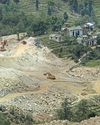Chhattisgarh stays mining operations in a Bailadila hill after protests by tribal people. But can it withstand pressure from mining giants?

IT WAS an unusual morning in Kirandul, a hilly town in southern Chhattisgarh. On June 7, as soon as day broke, thousands of people from 200- odd tribal villages surrounding the Bailadila hill range started congregating at the gates of the National Mineral Development Corporation (NMDC), a public sector unit that runs all iron ore mines in the hill. Carrying food and drums, and wielding ax, bows, and arrows, they had come prepared for a long fight and declared an indefinite protest against NMDC’s attempt to raze a distant green hill, which they referred to as the abode of Nandaraj, their nature god.
Their mood is reminiscent of the rage among forest dwellers of Odisha’s Niyamgiri hills during the country’s first environment referendum in 2015. The Supreme Court had asked Dongria Kondh and several other tribal communities, who worship the hills as their deity, to decide if mining in the hills would affect their religious and cultural rights. At least 10 villages had unanimously rejected the proposal, forcing the state government-owned Odisha Mining Corporation and London-based Vedanta Resources to abandon the plans of extracting bauxite from the hills and supply it to Vedanta’s alumina refinery.
Bu hikaye Down To Earth dergisinin July 01, 2019 sayısından alınmıştır.
Start your 7-day Magzter GOLD free trial to access thousands of curated premium stories, and 9,000+ magazines and newspapers.
Already a subscriber ? Giriş Yap
Bu hikaye Down To Earth dergisinin July 01, 2019 sayısından alınmıştır.
Start your 7-day Magzter GOLD free trial to access thousands of curated premium stories, and 9,000+ magazines and newspapers.
Already a subscriber? Giriş Yap

A SPRIG TO CARE FOR
Punarnava, a perennial herb, is easy to grow and has huge health benefits

DIGGING A DISASTER
Soapstone mining near Dabti Vijaypur village has caused many residents to migrate.

REVIEW THE TREATMENT
Several faecal sludge treatment plants in Uttar Pradesh suffer from design flaws that make the treatment process both expensive and inefficient

MAKE STEEL SUSTAINABLE
As India works to double its GDP by 2030, its steel industry must balance growth with sustainability. By embracing policies like the Steel Scrap Recycling Policy 2019 and adopting green technologies, India is paving the way for a more sustainable future in steel production

Can ANRF pull off the impossible for India?
Anusandhan National Research Foundation is expected to reorient India's innovation goals but funding issues, old mindsets remain a drag

TROUBLED WOODS
Forests are a great bulwark against climate change. But this is fast changing. AKSHIT SANGOMLA travels through some of the pristine patches of the Western Ghats to explore how natural disturbances triggered by global warming now threaten the forest health

BLINDING GLOW
The science is clear: increased illumination has damaging consequences for the health of humans, animals and plants. It’s time governments introduced policies to protect the natural darkness and improved the quality of outdoor lighting.

GROUND REALITY
What happens when the soil loses the ability to grow healthy, high-yield crops on its own?

GM POLICY MUST BE FARMER CENTRIC
On July 23, the Supreme Court of India directed the Union government to develop a national policy on genetically modified (GM) crops for research, cultivation, trade and commerce through public consultation.

Vinchurni's Gandhi
A 96-year-old farmer transforms barren land into a thriving forest in drought-prone region of Satara